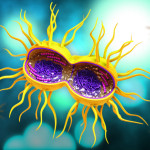Five amino acids—tiny fragments of a protein called HLA-B—are what separate an elite group of HIV-positive people who naturally do not progress to AIDS from those living with the virus who will invariably develop AIDS without lifelong antiretroviral treatment, according to an important paper published November 4 on the website of the journal Science.
Under the direction of Bruce Walker, MD, from the Ragon Institute of Massachusetts General Hospital in Boston, a team of researchers sorted through 1.4 million bits of DNA to determine the rare gift of HIV control and immune system health among untreated long-term nonprogressors (LTNPs). The hope is that once researchers identify this gift, they can then replicate it in HIV-positive people with progressive disease.
“HIV is slowly revealing its secrets, and this is yet another,” Walker said. “Knowing how an effective immune response against HIV is generated is an important step toward replicating that response with a vaccine. We have a long way to go before translating this into a treatment for infected patients and a vaccine to prevent infection, but we are an important step closer.”
It has been known for almost two decades that a small minority—about one in 100—of individuals infected with HIV are able to live with HIV infection without showing any symptoms of disease progression, despite having a detectable viral load. Even more unique is a subset of LTNPs known as HIV controllers, who maintained undetectable viral loads, in the absence of treatment, without any obvious signs of immune system damage.
In an effort to better understand this rare ability, researchers have been exploring genetic differences between LTNPs and HIV progressors. This led to the creation of the International HIV Controllers Study in 2006 by Florencia Pereyra, MD, of the Ragon Institute and her colleagues. The initial goal was to enroll 1,000 HIV controllers from medical clinics and research institutes around the world. That goal was expanded to 2,000 controllers in 2008, and thus far more than 1,500 controllers have been enrolled.
Early research suggested that certain genes involved with the HLA system—molecules that help the immune system differentiate between “self” and “invaders”—were important for HIV control. “But they couldn’t tell us exactly which genes were involved and how they produced this difference,” explained Paul de Bakker, PhD, of the Brigham and Women’s Hospital in Boston and a coauthor of the study. “Our findings take us not only to a specific protein, but to a part of that protein that is essential to its function.”
The current investigation began with a genome-wide association study (GWAS) of almost 1,000 controllers and 2,600 individuals with progressive HIV infection. The GWAS, which tests variations at a million points in the human genome, identified some 300 sites that were statistically associated with immune control of HIV, all in regions of chromosome 6 that code for HLA proteins. Further analysis narrowed the number of gene sites to four but could not indicate whether those differences actually affected viral control or were just located near the causal variants. Fully sequencing that genome region in all participants was not feasible, but a process developed by Sherman Jia—a medical student in the Harvard-MIT Health Sciences and Technology program—pinpointed specific amino acids; and directly testing those sites associated five amino acids in the HLA-B protein with differences in viral control.
HLA-B is essential to the process by which the immune system recognizes and destroys virus-infected cells. Usually HLA-B grabs onto viral protein segments called peptides that are inside the cell and carries them to the cell membrane where they essentially flag the infected cell for destruction by CD8 “killer” T cells. The portion of the HLA-B protein that grabs and displays viral peptides is called the binding pocket, and all of the five identified amino acid sites are in the lining of the binding pocket.
“Amino acid variation within the HLA-B binding pocket will impact its shape and structure, probably resulting in some peptides being presented effectively and others not,” de Bakker says. “Our work demonstrates that these variants could make a crucial difference in the individual’s ability to control HIV by changing how HLA-B presents peptides from this virus to the immune system.”
This research’s ultimate goal is to clarify the mechanisms in which nonprogressors naturally control HIV and then to use that information to design a vaccine. “If we can replicate the natural phenomenon seen in HIV controllers (low levels of virus loads without medication) then we can impact the epidemic by decreasing HIV transmission and disease progression,” said Paul McLaren, a postdoctoral fellow at the Broad Institute in Cambridge and another coauthor of the study. “There are a lot of steps between now and then, but that’s the ultimate goal.”






17 Comments
17 Comments